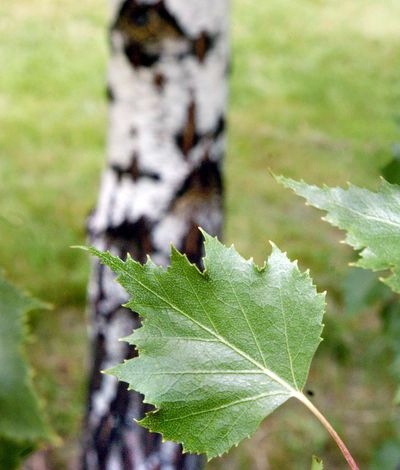Birch trees need plenty of water

Got a birch tree that doesn’t look too healthy after our long, dry summer? You aren’t alone. Both European white birch and river birch are popular landscape trees in the Inland Northwest. However, they aren’t easy to keep healthy here.
In their natural habitat, birches live along the forest edges or near streams where their roots can stay cool and moist even during the hottest part of the year. Their roots are very shallow and very sensitive to dry conditions even for a very short period. At the edge of the forest or near a stream, their roots are shaded by other trees or watered from a nearby stream while their crowns reach into the full sun.
Unfortunately, when birches are planted in the landscape, their need for cool roots and a steady water supply are often ignored. Many homeowners want to showcase the beautiful bark of the European white birch or the river birch in a prominent place. Unfortunately, that usually means the middle of the front lawn exposed to the hot sun and surrounded by the most water hungry plant in the garden – lawn.
As a result, instead of their roots being cooled by the shade of other trees, they are sitting out in the hot sun with the lawn planted above their roots sucking up most of the moisture.
To finish the injustice, most homeowners then rely on the sprinklers set to keep the lawn happy (1 inch per week) and expect it to also water the birch. It won’t. Sprinklers set for lawns don’t soak down to the birch roots. The result is a stressed tree that begins dying back after a few short years. A birch under water stress is a magnet for bronze birch borers.
The birch borer is a small, bronze-colored beetle that attacks weakened or stressed birches from May to August. The insects are drawn to stressed trees by the release of a physiological signal. The presence of D-shaped holes in the trunk indicates the borers are in the tree.
The females lay eggs on the trunk of the tree. The larvae then bore into the tree and feed on the cambium layer, eventually eating their way around the trunk and girdling the tree, cutting off the tree’s ability to transport water and food, thus killing it. A tree will often die in stages. First the top will die followed slowly by other parts of the tree over a few years.
To reduce the potential of borer attacks, deep soak the trees regularly. Avoid pruning trees in the summer as fresh wounds draw borers. Paint the lower tree trunks with carbaryl (Sevin) in April and any wounds through the summer to kill curious females who might be looking for a place to lay eggs. Once the larvae are inside the tree, there is no way to reach them. Apply the carbaryl according to label directions late in the day to prevent chance contact with honey bees.